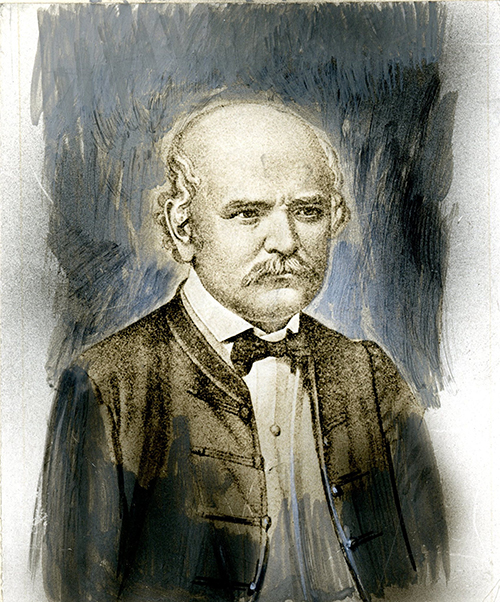Die aetiologie, der bergriff und die prophylaxis des kindbettfiebers. Pest, Wien und Leipzig: C. A. Hartleben, 1861.
 Ignaz Semmelweis, a Hungarian obstetrician working in Vienna in the mid-nineteenth century, made a crucial discovery about puerperal fever that helped usher in the use of antiseptics. In 1846, the Vienna General Hospital (Allgemeines Krankenhaus) had two obstetrics clinics, and Semmelweis was a surgeon, clinician, and instructor of medical students in the first clinic. The second clinic was only different in that it was used for the instruction of midwives instead of physicians. It was, therefore, baffling that the second had such a drastically smaller percentage of patient deaths by puerperal fever (childbed fever), an infection that occurs after childbirth or abortion. The first clinic had attained such a reputation for deaths by the fever that women cried and begged not to be taken into it (Garrison 435). Semmelweis, in an attempt to resolve this problem in his clinic, began studying autopsies of puerperal fever fatalities. When his friend and former instructor, Kolletschka, died of an infected wound accidentally inflicted during a postmortem dissection, Semmelweis was present during this autopsy also. Because of his careful observations of puerperal fever victims, he was able to recognize that these women had experienced the same pathological changes as Kolletschka did from his infected wound. He deduced that puerperal fever, like Kolletschka’s disease was transmitted through the blood, and that medical students were bringing it into the first clinic from the dissection table. Semmelweis noticed that the medical students in the first clinic, unlike the midwives in the second, were treating women directly after dissections and without washing their hands. Once he instated a policy requiring the students to wash their hands and scrub them in chlorine water before examining women, the clinic’s puerperal fever death rate drastically dropped (Clendening 603-604). When he extended the policy to cover all instruments used on laboring women, he practically eliminated the fever from his hospital (Dict. Sci. Bio., Vol. 11&12, p. 295).
Ignaz Semmelweis, a Hungarian obstetrician working in Vienna in the mid-nineteenth century, made a crucial discovery about puerperal fever that helped usher in the use of antiseptics. In 1846, the Vienna General Hospital (Allgemeines Krankenhaus) had two obstetrics clinics, and Semmelweis was a surgeon, clinician, and instructor of medical students in the first clinic. The second clinic was only different in that it was used for the instruction of midwives instead of physicians. It was, therefore, baffling that the second had such a drastically smaller percentage of patient deaths by puerperal fever (childbed fever), an infection that occurs after childbirth or abortion. The first clinic had attained such a reputation for deaths by the fever that women cried and begged not to be taken into it (Garrison 435). Semmelweis, in an attempt to resolve this problem in his clinic, began studying autopsies of puerperal fever fatalities. When his friend and former instructor, Kolletschka, died of an infected wound accidentally inflicted during a postmortem dissection, Semmelweis was present during this autopsy also. Because of his careful observations of puerperal fever victims, he was able to recognize that these women had experienced the same pathological changes as Kolletschka did from his infected wound. He deduced that puerperal fever, like Kolletschka’s disease was transmitted through the blood, and that medical students were bringing it into the first clinic from the dissection table. Semmelweis noticed that the medical students in the first clinic, unlike the midwives in the second, were treating women directly after dissections and without washing their hands. Once he instated a policy requiring the students to wash their hands and scrub them in chlorine water before examining women, the clinic’s puerperal fever death rate drastically dropped (Clendening 603-604). When he extended the policy to cover all instruments used on laboring women, he practically eliminated the fever from his hospital (Dict. Sci. Bio., Vol. 11&12, p. 295).
Despite opposition from professional peers, Semmelweis stood by his findings and pioneered the use of antiseptics in obstetrics. By working hard to improve conditions for obstetrics wards in both Hungary and Vienna, he holds a place in the history and advancement of obstetrics as well as for discovering that puerperal fever is caused by microorganisms transmitted through the blood stream (Garrison & Morton 6277). The Reynolds-Finley Library has a first edition copy of his book, Die aetiologie, der bergriff und die prophylaxis des kindbettfiebers, or “The cause, concept and prevention of child-bed fever”, which was published in 1861. The work was not well received by the prominent physicians of the day, and it prompted conflicts which took their toll on Semmelweis. He was eventually committed to an insane asylum and died a few weeks later, ironically of an infection caused by a wound.
Clendening, Source Book of Med. Hist., pp. 603-604; Dict. Sci. Bio., Vol. 11&12, pp. 294-296; Garrison, Hist. of Med., 4th Edition, pp. 435; Garrison & Morton, Med. Bib., 5th Edition, 6277; Reynolds Historical Library, Rare books and coll…, 3748.
Image: Ignaz Semmelweis, Print Collection, Reynolds-Finley Historical Library.
